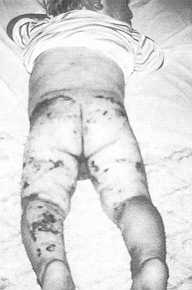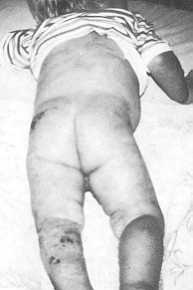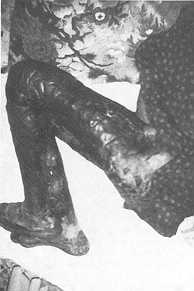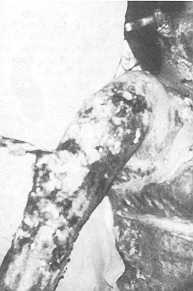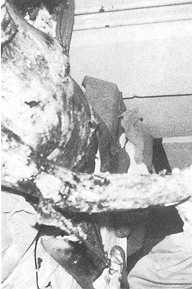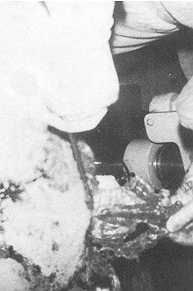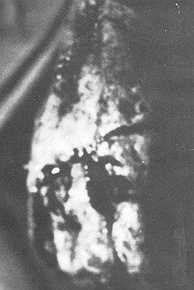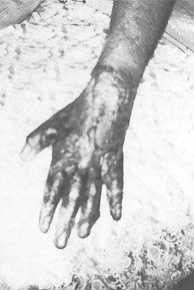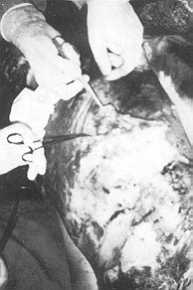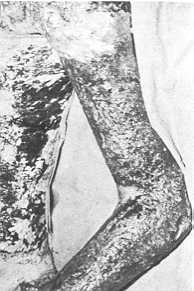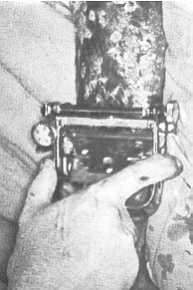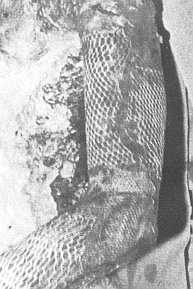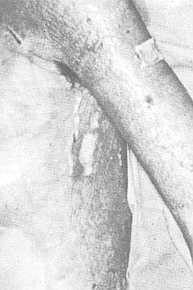Annals of the MBC - vol. 3 - n' 2 - June 1990 SEPARATION OF THE ESCHARDayoub A. Faculty of Medicine, Aleppo University, Syria SUMMARY. The are two main ways of removing the eschar that forms after third-degree bums: spontaneous separation (including removal by medication) and surgical separation. Both methods are equally valid in clinical practice, and neither is to be preferred to the other as a matte r of principle. The two techniques are described. Treatment of third-degree eschar The treatment of third-degree burn wounds includes the removal of the eschar and transplantation of skin. In this paper the problem of removal of the eschar is discussed. In principle, there are two ways of removing the eschar: by spontaneoLus__~eparation (including removal by medication) and by surgical measures. In clinical practice, we should use both methods, without favouring one and neglecting the other.
Spontaneous separation of eschar by "silkworm bite" After the self-dissolved necrotic
tissue of third-degree eschar is separated from the new growth of granulation tissue, the
already separated and loosened eschar should be scissored off immediately. The manoeuvre
must be conducted gently, so as to avoid bleeding if possible.
This is due to the fact that at this time
the ability of the wound to accept skin graft is at its maximum; delay may cause a
valuable opportunity to be missed. The longer the granulation tissue is exposed, the
greater is (a) the chance of infection and (b) general debilitation. Therefore, after the
eschar has been cast off, the principle of "grafting as much as possible" should
be adopted to ensure that the wound is covered with autografts or allografts in time. In
the case of extensive bums, coverage with skin should be done as soon as the granulating
wounds are exposed.
One should therefore protect one part of
the eschar while causing another part to separate earlier. To "protect" the
eschar means to protect its integrity and dryness, and to minimize pressure bearing. On
the other hand, to promote the separation of the eschar, the best technique is to moisten
it. Escharectomy Escharectomy is a very effective
method of eschar removal. The result is cosmetically superior to wounds which have been
treated by excision to the fascia and in selected cases significantly shortens hospital
stay and hastens rehabilitation. It may be used at the primary modality of therapy or as
an adjunct to conservative therapy.
Eschar excision For deep third-degree bums, excision of the eschar in combination with skin grafting may be used. It is possible to cover the wound at an earlier date, thereby shortening the course of treatment and avoiding various complications. For third-degree bums located in the hand or functional parts of the joints, after eschar excision and grafting of large sheets of skin, contracture may be reduced to a minimum and recovery of function is satisfactory. Comparatively speaking, this is therefore an ideal method.
Timing The timing of excision should be determined by the patient's general condition, the total burned area, and the extent of third-degree burn.
The time of the first excision operation should, as a rule, be about 5 days after injury, when the patient has already passed the shock stage and is in a relatively stable condition, and oedema has essentially been reabsorbed. Size and location of excision As to the selection of locality, as a rule the extremities are chosen first and the trunk of the body afterwards, the principal reasons being:
The interval between two excisions As a rule, the interval is about 3 days, if the general condition of the patient is stable, in which cAe it may be suitably shortened. It is necessary to make good use of the 2 weeks post-bum for operations, since this is the most opportune time. RESUMÉ. Il y a deux méthodes principales pour décoller l'escarre qui se forme à la suite des brûlures de troisième degré: la séparation spontanée (y compris la séparation médicale) et la séparation chirurgicale. Toutes les deux techniques sont valides dans la pratique clinique, et il ne faut pas préférer l'une ou l'autre par principe. L'Auteur décrit les deux méthodes. |
